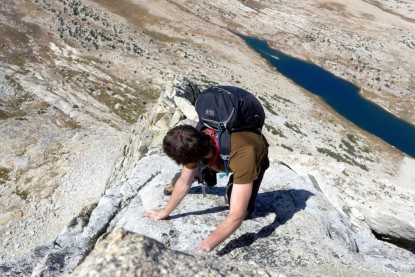This was not our favorite pack so it is no surprise to use that it's now discontinued. See the reviews for our award winning packs the Editors' Choice Black Diamond Bullet and Best Buy REI Flash 18.
The Mountain Hardwear Crimper scored lowest overall of all the packs tested, by a long shot. It is a full four ounces (120 grams) heavier than its next closest competitor, the Petzl Bug, and it has a 5L less space. These two packs are the most comparable of the packs we tested: they both have padded backs, and are fully-featured, climbing specific packs, compete with a full external daisy chain. The Bug, however, has more innovative features designed specifically for climbing, so in a head to head, there is really no comparison; the Bug is a better pack. The only category in which it wins out over the Bug is in versatility, since the Crimper can function better as an around town pack, and would work better for short multi-pitch ice climbs.
If you are looking specifically for a pack that has a tool loop, the only other pack that has one is the REI Flash 18, and the Crimper is better equipped (you have to rig your own top attachment point on the Flash 18). An axe can also be rigged to the outside of the Cilo Gear 20L Worksack using its customizable straps (see photo on the Cilo Gear 20L Worksack review), and the pack itself is more appropriate for an alpine venture where an axe might be necessary. The weight of the Crimper seems to preclude it from any real alpine use. If you are doing mixed lines or alpine climbs where you will be taking tools off and on your pack often, consider going for a slightly larger, fully equipped 30L pack instead, with real tool loops instead of just a set of bungees.
The Crimper is nearly twice the weight of our Editors' Choice pick, the Black Diamond Bullet (13 ounces). It is certainly not twice the pack! Quite the opposite. It is also $20 more. The choice seems clear here.
Mountain Hardwear carried over the materials, workmanship, and features (not to mention its rock-solid lifetime guarantee), from its larger packs to this small offering. Unfortunately, they didnt get the recipe quite right. This pack is too heavy and beefy for a multi-pitch rock climbing pack, too small and too climbing oriented to excel as a hiking specific pack. Its hidden exterior pocket is innovative and a highlight, and some of the other features are useful, but none are good enough to redeem this pack. Look elsewhere.



